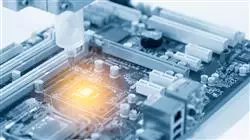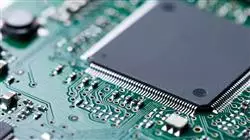University certificate
The world's largest faculty of information technology”
Introduction to the Program
By taking this course you will learn how to design and repair electronic systems that make people's daily lives easier"

Embedded Electronic Systems are widely used today for applications that require real time signal processing. These can have a single processor or several processors working in a distributed manner. In the case of networks, it also highlights the importance of knowing the different types of networks and the risks of suffering attacks that compromise them, as well as the mechanisms for exclusion and acceptance of nodes, and protection of the network and data.
The complexity of these aspects has led to the need to create specific academic programs that allow computer scientists to specialize in an area that is related to everyday aspects. Thus, TECH Postgraduate certificate in Embedded Electronic Systems develops the current techniques, software and hardware, to solve problems that require real time signal processing, which can be distributed systems.
The program also covers the design of electronic systems, focusing on portable devices (computers, cell phones, diagnostic tools, etc.). In this way, the enclosures of electronic devices are examined with an increasingly high level of integrity, among other aspects.
In short, this is a 100% online Postgraduate certificate that will allow students to distribute their study time, not being restricted by fixed schedules or having to move to another physical location, being able to access all the contents at any time of the day, balancing their work and personal life with their academic life.
Access a multitude of case studies that will help you to reinforce your theoretical knowledge"
This Postgraduate certificate in Embedded Electronic Systems contains the most complete and up to date educational program on the market. The most outstanding characteristics of this program are:
- Practical cases presented by experts in information technology
- The graphic, schematic, and practical contents with which they are created, provide scientific and practical information on the disciplines that are essential for professional development
- Practical exercises where the self assessment process can be carried out to improve learning
- Special emphasis on innovative methodologies in Embedded Electronic Systems
- Theoretical lessons, questions to the expert, debate forums on controversial topics, and individual reflection assignments
- Content that is accessible from any fixed or portable device with an Internet connection
Get to know the particularities of TECH and be successful in this field"
Its teaching staff includes professionals from the field of IT, who bring to this program the experience of their work, as well as renowned specialists from leading societies and prestigious universities.
The multimedia content, developed with the latest educational technology, will provide the professional with situated and contextual learning, i.e., a simulated environment that will provide an immersive training experience designed to train for real life situations.
This program is designed around Problem Based Learning, whereby the student must try to solve the different professional practice situations that arise throughout the program. For this purpose, the student will be assisted by an innovative interactive video system created by renowned and experienced experts.
A superior specialization course that will help to give you a boost in your career"

A 100% online training that will allow you to study from anywhere in the world"
Why study at TECH?
TECH is the world’s largest online university. With an impressive catalog of more than 14,000 university programs available in 11 languages, it is positioned as a leader in employability, with a 99% job placement rate. In addition, it relies on an enormous faculty of more than 6,000 professors of the highest international renown.

Study at the world's largest online university and guarantee your professional success. The future starts at TECH”
The world’s best online university according to FORBES
The prestigious Forbes magazine, specialized in business and finance, has highlighted TECH as “the world's best online university” This is what they have recently stated in an article in their digital edition in which they echo the success story of this institution, “thanks to the academic offer it provides, the selection of its teaching staff, and an innovative learning method aimed at educating the professionals of the future”
A revolutionary study method, a cutting-edge faculty and a practical focus: the key to TECH's success.
The most complete study plans on the university scene
TECH offers the most complete study plans on the university scene, with syllabuses that cover fundamental concepts and, at the same time, the main scientific advances in their specific scientific areas. In addition, these programs are continuously being updated to guarantee students the academic vanguard and the most in-demand professional skills. In this way, the university's qualifications provide its graduates with a significant advantage to propel their careers to success.
TECH offers the most comprehensive and intensive study plans on the current university scene.
A world-class teaching staff
TECH's teaching staff is made up of more than 6,000 professors with the highest international recognition. Professors, researchers and top executives of multinational companies, including Isaiah Covington, performance coach of the Boston Celtics; Magda Romanska, principal investigator at Harvard MetaLAB; Ignacio Wistumba, chairman of the department of translational molecular pathology at MD Anderson Cancer Center; and D.W. Pine, creative director of TIME magazine, among others.
Internationally renowned experts, specialized in different branches of Health, Technology, Communication and Business, form part of the TECH faculty.
A unique learning method
TECH is the first university to use Relearning in all its programs. It is the best online learning methodology, accredited with international teaching quality certifications, provided by prestigious educational agencies. In addition, this disruptive educational model is complemented with the “Case Method”, thereby setting up a unique online teaching strategy. Innovative teaching resources are also implemented, including detailed videos, infographics and interactive summaries.
TECH combines Relearning and the Case Method in all its university programs to guarantee excellent theoretical and practical learning, studying whenever and wherever you want.
The world's largest online university
TECH is the world’s largest online university. We are the largest educational institution, with the best and widest online educational catalog, one hundred percent online and covering the vast majority of areas of knowledge. We offer a large selection of our own degrees and accredited online undergraduate and postgraduate degrees. In total, more than 14,000 university degrees, in eleven different languages, make us the largest educational largest in the world.
TECH has the world's most extensive catalog of academic and official programs, available in more than 11 languages.
Google Premier Partner
The American technology giant has awarded TECH the Google Google Premier Partner badge. This award, which is only available to 3% of the world's companies, highlights the efficient, flexible and tailored experience that this university provides to students. The recognition as a Google Premier Partner not only accredits the maximum rigor, performance and investment in TECH's digital infrastructures, but also places this university as one of the world's leading technology companies.
Google has positioned TECH in the top 3% of the world's most important technology companies by awarding it its Google Premier Partner badge.
The official online university of the NBA
TECH is the official online university of the NBA. Thanks to our agreement with the biggest league in basketball, we offer our students exclusive university programs, as well as a wide variety of educational resources focused on the business of the league and other areas of the sports industry. Each program is made up of a uniquely designed syllabus and features exceptional guest hosts: professionals with a distinguished sports background who will offer their expertise on the most relevant topics.
TECH has been selected by the NBA, the world's top basketball league, as its official online university.
The top-rated university by its students
Students have positioned TECH as the world's top-rated university on the main review websites, with a highest rating of 4.9 out of 5, obtained from more than 1,000 reviews. These results consolidate TECH as the benchmark university institution at an international level, reflecting the excellence and positive impact of its educational model.” reflecting the excellence and positive impact of its educational model.”
TECH is the world’s top-rated university by its students.
Leaders in employability
TECH has managed to become the leading university in employability. 99% of its students obtain jobs in the academic field they have studied, within one year of completing any of the university's programs. A similar number achieve immediate career enhancement. All this thanks to a study methodology that bases its effectiveness on the acquisition of practical skills, which are absolutely necessary for professional development.
99% of TECH graduates find a job within a year of completing their studies.
Postgraduate Certificate in Embedded Electronic Systems
.
In today's world, embedded electronic systems are the backbone of numerous devices and systems that we use on a daily basis, often without even realizing their presence. These systems, also known as embedded systems, are a combination of hardware and software designed to accomplish specific tasks and operate efficiently and reliably. Are you ready to delve into the exciting world of embedded electronic systems? This Postgraduate Certificate is your gateway to this fascinating technological discipline that drives innovation in a variety of industries. Our team of highly experienced industry faculty will guide you through this learning experience. You will learn to use cutting-edge tools and technologies, including integrated development environments (IDEs) and system simulators, in order to design, prototype and debug complex embedded electronic systems.
Get your degree with a Postgraduate Certificate in Embedded Electronic Systems .
In an increasingly interconnected world, embedded electronic systems play a key role in automating processes and improving efficiency in a wide range of applications, including manufacturing, automotive, healthcare, renewable energy and smart devices. This program focuses on providing you with a solid understanding of the fundamental principles and advanced techniques in the design, development and programming of embedded electronic systems. Through a combination of theory and practice, you will acquire key skills in areas such as integrated circuit design, the use of microcontrollers and microprocessors, programming in low-level languages and the development of real-time systems. All this, without having to leave home, with the best teaching tutorials and interactive material that will give that rewarding plus to your professional profile.







